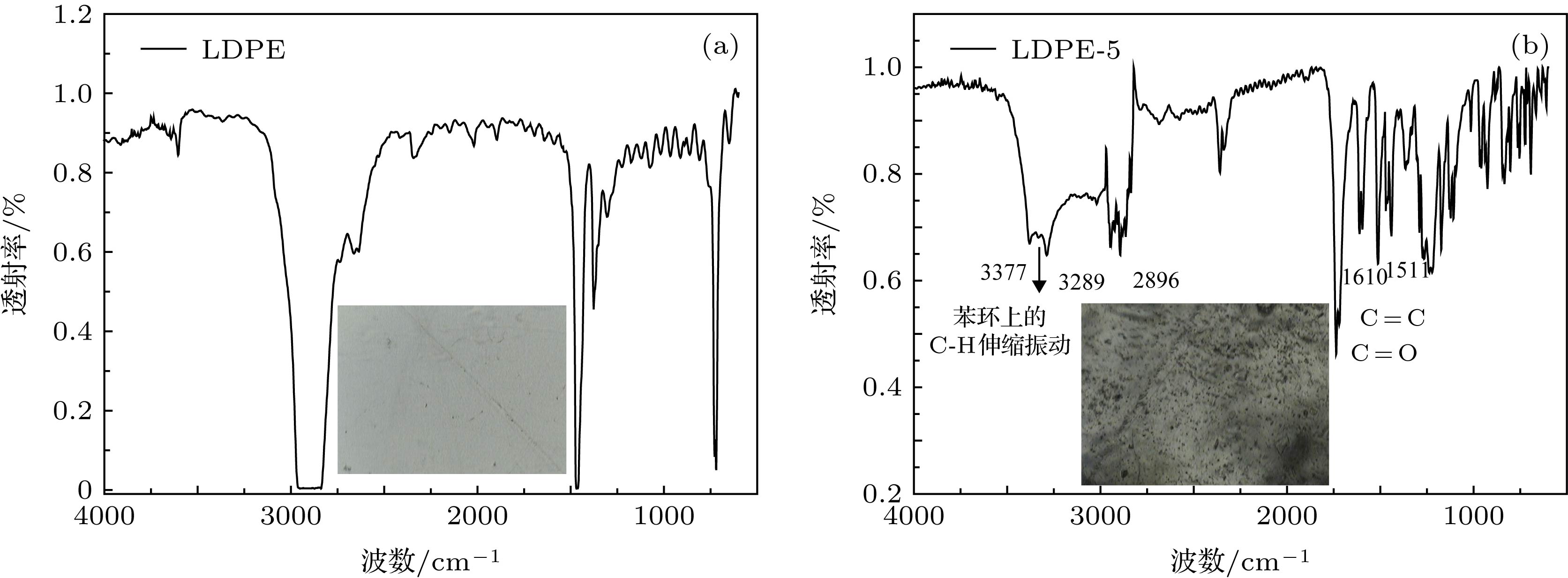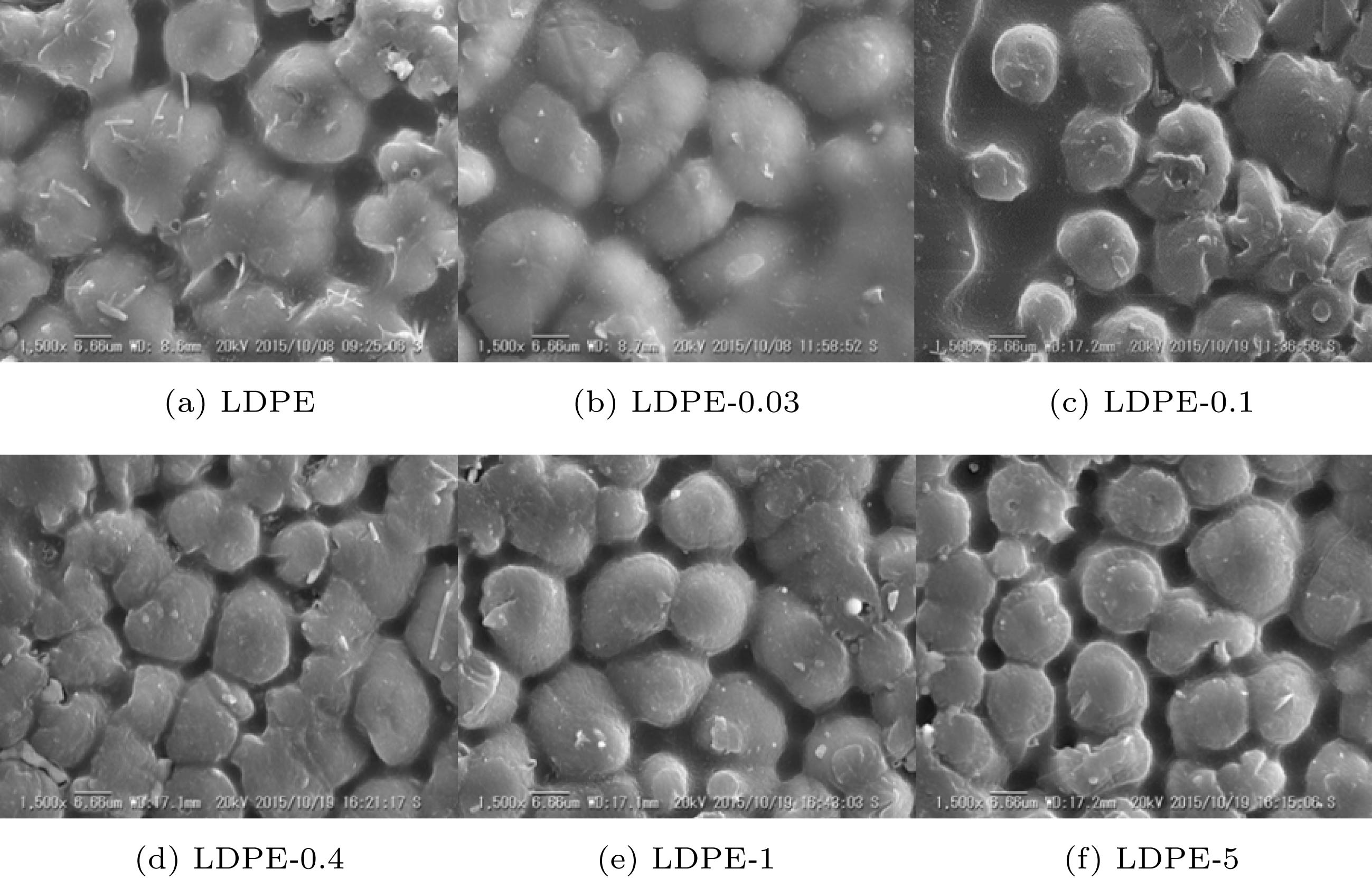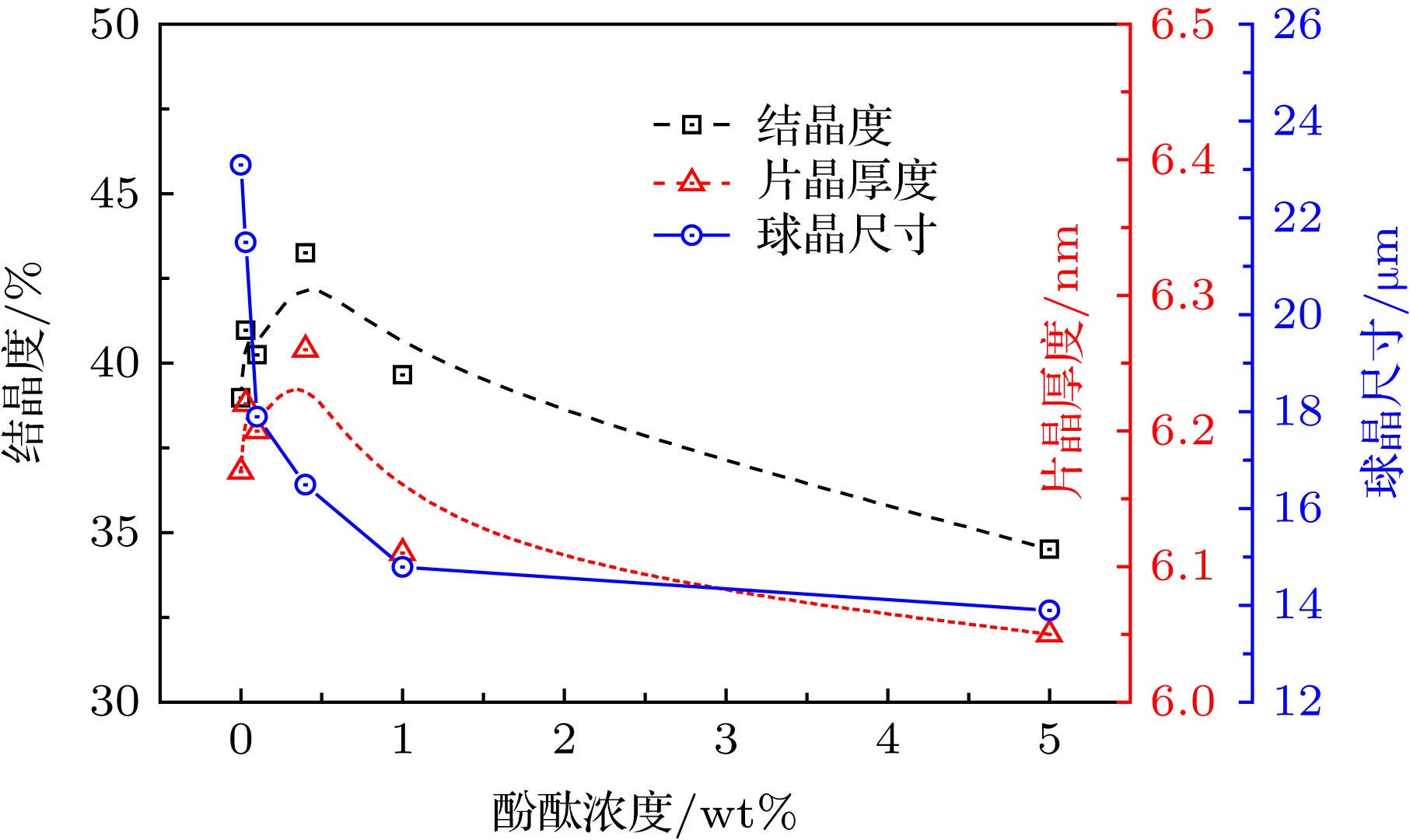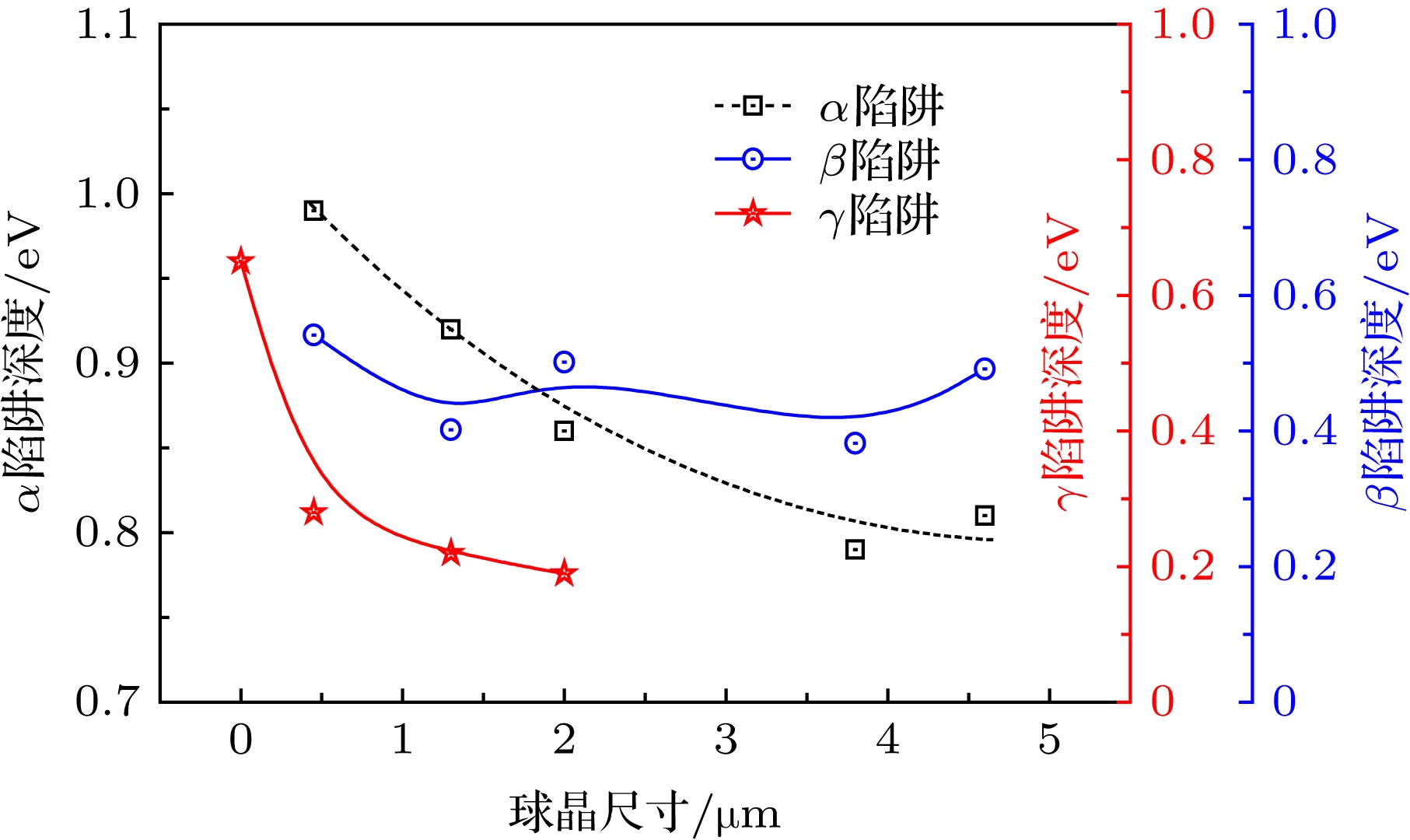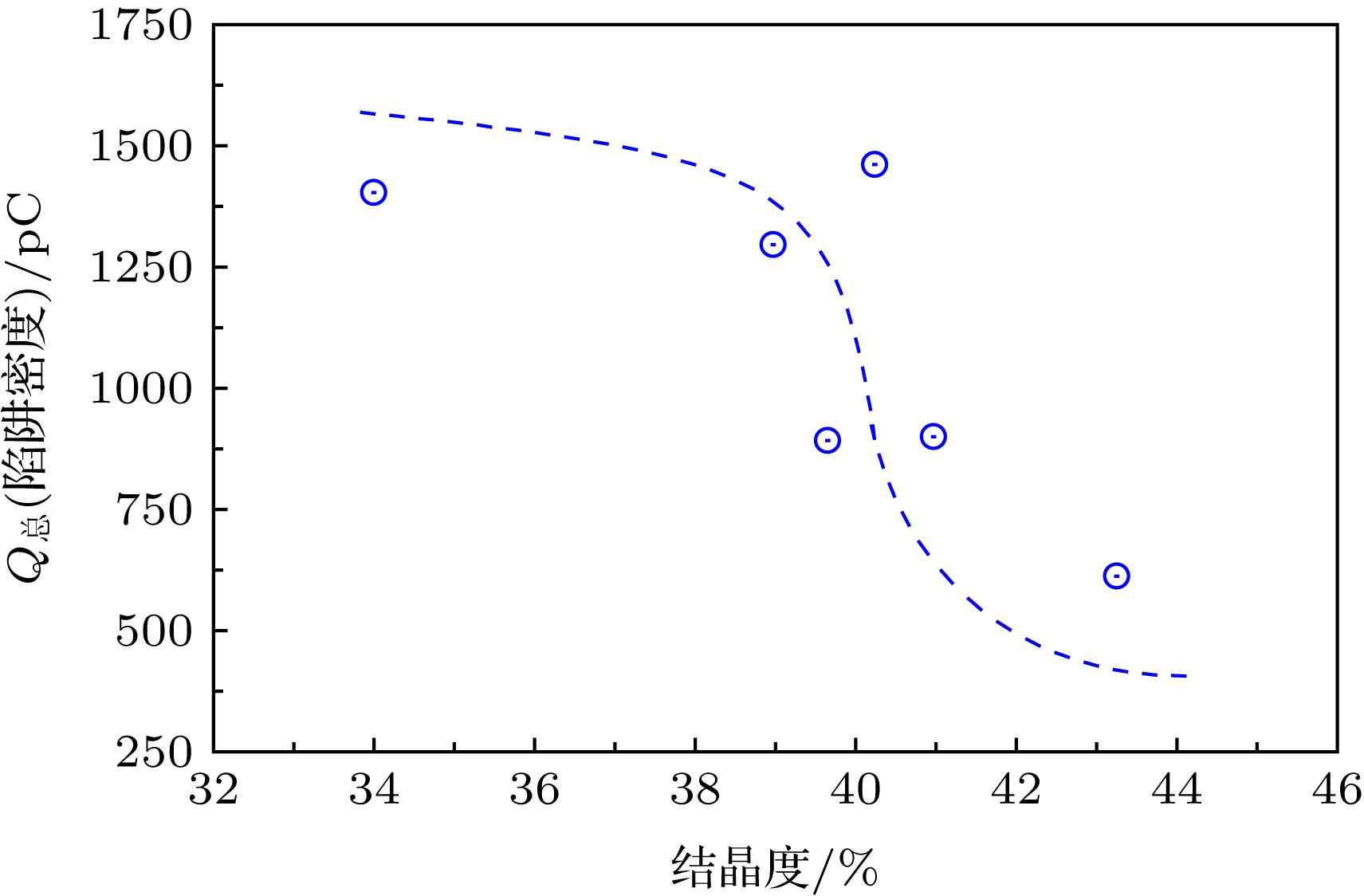-
Surface flashover is the primary limitation to the development of power system and the increase of voltage level. Previous work has proved that the trap can greatly influence flashover performances, but the relationship between trap parameters and surface flashover voltage is not clear. In the paper, we study the effects of crystallization behavior, microstructure, and trap parameters on DC surface flashover performance of semi-crystallinity polymer through adding phenolphthalein which is regarded as nucleating agent in low density polyethylene (LDPE). Micro-IR spectroscopy result proves that phenolphthalein exactly exists in LDPE/phenolphthalein composite. Differential scanning calorimeter (DSC) and scanning electron microscope (SEM) are used to investigate the effect of nucleating agent (phenolphthalein) on crystallinity behavior and microstructure of LDPE, and their results indicate that the phenolphthalein modification greatly changes the crystallization behavior of LDPE. The SEM results show that the spherulite size of LDPE decreases and is distributed more uniformly with the increase of phenolphthalein concentration. The DSC results show that the crystallinity and lamella thickness increase. Thermally stimulated depolarization current (TSDC) is used to characterize the trap parameters of LDPE/phenolphthalein composites. The TSDC results indicate that the shallow trap level (γ peak) increases from 0.19 eV to 0.65 eV and the deep trap (α peak) increases from 0.81 eV to 0.99 eV with the increase of phenolphthalein concentration. Relationship between microstructure and trap parameters shows that the smaller spherulite size indicates the deeper trap level (for LDPE, the trap level increases from 0.81 eV to 0.99 eV when the spherulite size decreases from 23.2 μm to 14.9 μm), and larger crystallinity means smaller trap density (for LDPE, the trap density decreases from 1404 pC to 612 pC when the crystallinity increases from 34.51% to 43.25%). The DC surface flashover performance increases with the increase of phenolphthalein concentration, and reaches a highest value: when the concentration is 1 wt%, the highest value is increased by 48.42%. Finally, it is concluded that the microstructure of semi-crystallinity polymerinfluences the trap parameters, which affects the surface flashover performance through affecting the carrier transport process in the development process of surface flashover. The trap level and trap density play complementary, cooperation and mutual transformation roles in improving the surface flashover performances as indicated by the analysis of the " U-shaped” relationship between trap parameters and flashover voltage.
-
Keywords:
- low density polyethylene /
- crystallization behavior /
- trap /
- vacuum surface flashover
[1] Anderson R A, Brainard J P 1980 J. Appl. Phys. 51 1414
 Google Scholar
Google Scholar
[2] Blaise G, Gressus C L 1991 J. Appl. Phys. 69 6334
 Google Scholar
Google Scholar
[3] Miller H C 2015 IEEE Trans. Electr. Insul. 22 3641
 Google Scholar
Google Scholar
[4] Shao T, Kong F, Lin H F, Ma YY, Xie Q, Zhang C 2018 IEEE Trans. Electr. Insul. 25 1267
 Google Scholar
Google Scholar
[5] Yang X, Zeng L L, Tang X, Song M 2017 IEEE Trans. Electr. Insul. 24 3452
 Google Scholar
Google Scholar
[6] Li C Y, H J, Lin C J, Zhang B Y, Zhang G X, He J L 2017 J. Phys. D: Appl. Phys. 50 065301
 Google Scholar
Google Scholar
[7] Li C Y, H J, Lin C J, He J L 2017 Sci. Rep. 7 03657-1
[8] 李盛涛, 黄奇峰, 孙健, 张拓, 李建英 2010 物理学报 59 422
 Google Scholar
Google Scholar
Li S T, Huang Q F, Sun J, Zhang T, Li J Y 2010 Acta Phys. Sin. 59 422
 Google Scholar
Google Scholar
[9] Yu S H, Li S T, Wang S H, Huang Y, Nazir T M, Phung B T 2018 IEEE Trans. Electr. Insul. 25 1567
 Google Scholar
Google Scholar
[10] 董烨, 董志伟, 周前红, 杨温渊, 周海京 2014 物理学报 63 067901
 Google Scholar
Google Scholar
Dong Y, Dong Z W, Zhou Q H, Yang W Y, Zhou H J 2014 Acta Phys. Sin. 63 067901
 Google Scholar
Google Scholar
[11] Shao T, Yang W J, Zhang C, Niu Z, Yan P, Schamiloglu E 2014 Appl. Phys. Lett. 105 071607
 Google Scholar
Google Scholar
[12] Huang Y, Min D M, Li S T, Li Z, Xie D R, Wang X 2017 Appl. Surf. Sci. 406 39
 Google Scholar
Google Scholar
[13] Zhao W, Xu R, Ren C Y, Wang J, Yan P 2018 IEEE Trans. Plasma Sci. 46 3450
 Google Scholar
Google Scholar
[14] Cheng Y H, Wang Z B, Wu K 2012 IEEE Trans. Plasma Sci. 40 68
 Google Scholar
Google Scholar
[15] Li S T, Li Z, Niu H, Fréchette M, Wang W W, Huang Y 2018 IEEE Technol. Soc. Mag. 12 6
[16] Zhao W B, Zhang G J, Yang Y, Yan Z 2007 IEEE Trans. Electr. Insul. 14 170
 Google Scholar
Google Scholar
[17] Jin L, Du B X, Xing Y Q, Jin J X 2016 IEEE Trans. Appl. Supercond. 26 1
[18] Li C R, Ding L J, Lü Z J, Tu Y P 2006 IEEE Trans. Electr. Insul. 13 79
 Google Scholar
Google Scholar
[19] Chen Y, Chen Y H, Wu K, Nelson J K 2009 IEEE Trans. Plasma Sci. 37 195
 Google Scholar
Google Scholar
[20] Li S T, Nie Y J, Wang W W, Yang L Q, Min D M 2016 IEEE Trans. Electr. Insul. 23 3215
 Google Scholar
Google Scholar
[21] Kitis G, Pagonis V, Tzamarias S E 2017 Ra. Meas. 100 27
 Google Scholar
Google Scholar
[22] Mizutani T, Suzuoki Y, Ieda M 1977 J. Appl. Phys. 48 2408
 Google Scholar
Google Scholar
-
表 1 酚酞掺杂试样的DSC熔融温度、结晶度、片晶厚度、球晶尺寸
Table 1. DSC parameters, crystallinity, lamella thickness, spherulite size.
试样 LDPE LDPE-0.03 LDPE-0.1 LDPE-0.4 LDPE-1 LDPE-5 Tm/℃ 112.7 112.9 112.8 113.1 112.4 112.1 ΔH/J·g–1 111.96 117.72 115.61 124.26 113.92 99.16 Xc/% 38.97 40.97 40.24 43.25 39.65 34.51 L/nm 6.17 6.22 6.20 6.26 6.11 6.05 球晶尺寸/μm 23.2 21.6 18.0 16.6 14.9 14.0 表 2 试样的真空直流沿面闪络电压
Table 2. DC surface flashover voltage in vacuum of specimens.
试样 LDPE LDPE-0.03 LDPE-0.1 LDPE-0.4 LDPE-1 LDPE-5 直流闪络电压/kV 30.17 31.33 36.70 41.67 46.50 43.60 表 3 酚酞改性LDPE试样的陷阱参数
Table 3. Trap parameters of phenolphthalein modified LDPE specimens.
试样 α 陷阱 β 陷阱 γ 陷阱 Q总/pC 深度/eV Qα/pC 深度/eV Qβ/pC 深度/eV Qγ/pC 纯LDPE 0.81 900 0.50 396 — — 1296 LDPE-0.03 0.79 408 0.39 492 — — 900 LDPE-0.1 0.86 768 0.51 672 0.19 21 1461 LDPE-0.4 0.92 165 0.41 396 0.22 51 612 LDPE-1 0.99 324 0.55 432 0.28 136 892 LDPE-5 0.68 348 — — 0.65 1056 1404 -
[1] Anderson R A, Brainard J P 1980 J. Appl. Phys. 51 1414
 Google Scholar
Google Scholar
[2] Blaise G, Gressus C L 1991 J. Appl. Phys. 69 6334
 Google Scholar
Google Scholar
[3] Miller H C 2015 IEEE Trans. Electr. Insul. 22 3641
 Google Scholar
Google Scholar
[4] Shao T, Kong F, Lin H F, Ma YY, Xie Q, Zhang C 2018 IEEE Trans. Electr. Insul. 25 1267
 Google Scholar
Google Scholar
[5] Yang X, Zeng L L, Tang X, Song M 2017 IEEE Trans. Electr. Insul. 24 3452
 Google Scholar
Google Scholar
[6] Li C Y, H J, Lin C J, Zhang B Y, Zhang G X, He J L 2017 J. Phys. D: Appl. Phys. 50 065301
 Google Scholar
Google Scholar
[7] Li C Y, H J, Lin C J, He J L 2017 Sci. Rep. 7 03657-1
[8] 李盛涛, 黄奇峰, 孙健, 张拓, 李建英 2010 物理学报 59 422
 Google Scholar
Google Scholar
Li S T, Huang Q F, Sun J, Zhang T, Li J Y 2010 Acta Phys. Sin. 59 422
 Google Scholar
Google Scholar
[9] Yu S H, Li S T, Wang S H, Huang Y, Nazir T M, Phung B T 2018 IEEE Trans. Electr. Insul. 25 1567
 Google Scholar
Google Scholar
[10] 董烨, 董志伟, 周前红, 杨温渊, 周海京 2014 物理学报 63 067901
 Google Scholar
Google Scholar
Dong Y, Dong Z W, Zhou Q H, Yang W Y, Zhou H J 2014 Acta Phys. Sin. 63 067901
 Google Scholar
Google Scholar
[11] Shao T, Yang W J, Zhang C, Niu Z, Yan P, Schamiloglu E 2014 Appl. Phys. Lett. 105 071607
 Google Scholar
Google Scholar
[12] Huang Y, Min D M, Li S T, Li Z, Xie D R, Wang X 2017 Appl. Surf. Sci. 406 39
 Google Scholar
Google Scholar
[13] Zhao W, Xu R, Ren C Y, Wang J, Yan P 2018 IEEE Trans. Plasma Sci. 46 3450
 Google Scholar
Google Scholar
[14] Cheng Y H, Wang Z B, Wu K 2012 IEEE Trans. Plasma Sci. 40 68
 Google Scholar
Google Scholar
[15] Li S T, Li Z, Niu H, Fréchette M, Wang W W, Huang Y 2018 IEEE Technol. Soc. Mag. 12 6
[16] Zhao W B, Zhang G J, Yang Y, Yan Z 2007 IEEE Trans. Electr. Insul. 14 170
 Google Scholar
Google Scholar
[17] Jin L, Du B X, Xing Y Q, Jin J X 2016 IEEE Trans. Appl. Supercond. 26 1
[18] Li C R, Ding L J, Lü Z J, Tu Y P 2006 IEEE Trans. Electr. Insul. 13 79
 Google Scholar
Google Scholar
[19] Chen Y, Chen Y H, Wu K, Nelson J K 2009 IEEE Trans. Plasma Sci. 37 195
 Google Scholar
Google Scholar
[20] Li S T, Nie Y J, Wang W W, Yang L Q, Min D M 2016 IEEE Trans. Electr. Insul. 23 3215
 Google Scholar
Google Scholar
[21] Kitis G, Pagonis V, Tzamarias S E 2017 Ra. Meas. 100 27
 Google Scholar
Google Scholar
[22] Mizutani T, Suzuoki Y, Ieda M 1977 J. Appl. Phys. 48 2408
 Google Scholar
Google Scholar
Catalog
Metrics
- Abstract views: 12397
- PDF Downloads: 90
- Cited By: 0














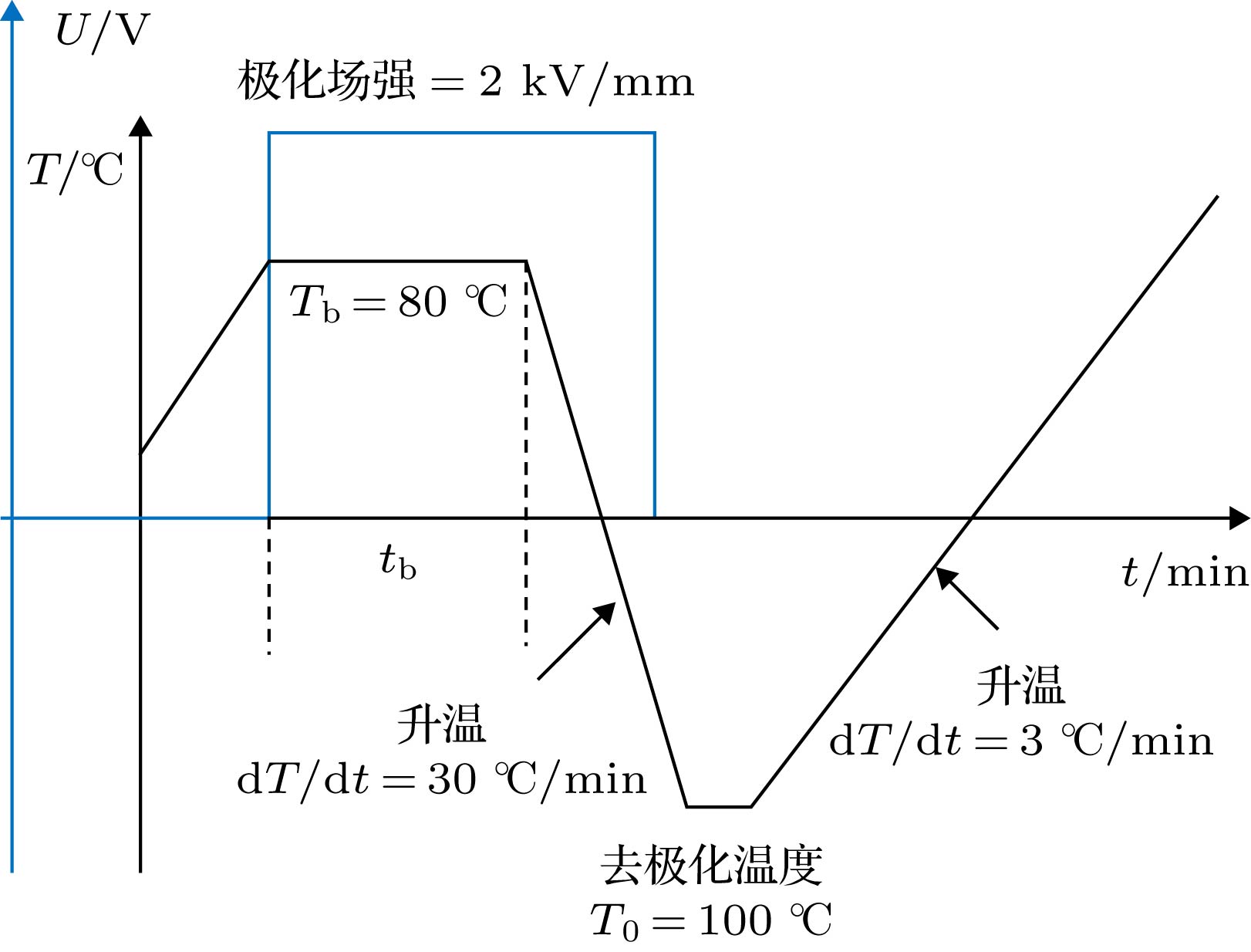
 DownLoad:
DownLoad:
